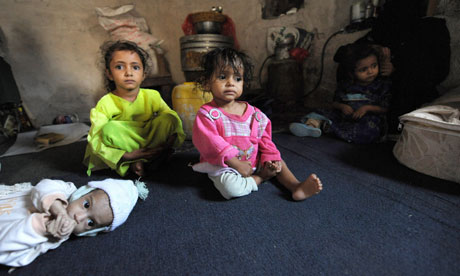By Justin Dorman
Impunity Watch Reporter, Middle East
SANA’A, Yemen – Political upheaval, civil war, and the presence of al-Qaeda have all largely been problems for Yemeni adults. Make no mistake, the existence of such conflicts have surely had a negative impact on the lives of the youth of Yemen.

Yemen is one of the poorest countries in the Middle East. It has a weak infrastructure and a perpetually struggling economy. As a result, Yemen is facing a horrible humanitarian crisis where at least ten million people suffer from chronic hunger, making Yemen the country with the second highest rate of chronic malnutrition in the world. Fifty-eight percent of the children there under the age of five experience chronic malnutrition. In an attempt to help, donors led by the British government met earlier this month in Saudi Arabia, where they pledged to donate a funding package of $6.4 billion.
While the children may not have much food, at least they have toys to play with. The truth is though that these toys could make the children just as sick as the malnutrition does. Children’s toys in Yemen have been linked to physical scarring, suffocation, and other invisible hazards that appear with the passage of time, like cancer. Hazardous toys have infiltrated the Yemeni markets because the importers seek cheap toys and the government really can’t afford to monitor the process.
Abdullah Al-Sharfi, manager of the Identification Certifcate Issuance Unit and Brand in the Yemeni Standardization and Quality Control Organization explained, “The Yemeni importer buys from the Chinese market, contrary to other importers in the region. The Yemeni importer doesn’t directly deal with the manufacturer. The problem lies in lacking the test reports, health or chemical certificates.”
Most of the screening done on toys once they have entered Yemen involves making sure the toys do not offend the morals of Islam. Importers go out of their way to make sure the toys enter the market without being tested, because if the toys must travel to the labs, importers face paying a customs fee which defeats the purpose of buying cheap toys that are exempt from the fees. A “qualities official in Hodeida lost his post because he attempted to apply the law,” said Mustafa Nassar, chairman of Studies and Economic Media Center. Importers lobbied the local council until he was removed.
Although the youth do not get much to eat and their toys are not very safe, at least they can still go to school to learn and peacefully interact with their friends. That was generally true until the 2011-2012 uprising caused government forces and other armed groups to deploy troops into schools. Forces occupied Yemeni schools and used them as barracks, bases, surveillance posts, firing positions, a place to store weapons and ammunition, to detain prisoners, and to torture detainees often while students and teachers were present in the buildings.

These occupations were not going to help raise Yemen’s literacy rate which was the lowest in the Middle East or its low enrollment rates. Besides for inhibiting education, these armed forces regularly put children’s lives at danger. Priyanka Motaparthy, a children’s rights researcher at Human Rights Watch stated that, “when soldiers and rebels deploy in schools, children and their education get put in harm’s way.”
The occupations also forced children to see things that they shouldn’t yet have seen. Ahlam, a thirteen year old student remembers how scared everyone was as the soldiers tortured an old man at their school. He recalls that, “they beat him [and] electro-shocked him right in the courtyard of the school. It was during recess.”
Many of these armed groups claimed that by using these schools they were also able to better protect the buildings, teachers, and students. International humanitarian law, however, states that in times of war, all feasible efforts are to be made to avoid civilians and that a school or other civilian structure cannot be attacked unless it is being used for military purposes. Motaparthy concludes that, “the moment soldiers enter a school, it becomes a military target and stops being a safe place for students.”
When these children grow a few years older and start attending university, life is still not safer. Security forces in Yemen often target students who engage in peaceful political protests. Theses students are then arbitrarily detained and are often subject to torture and other ill-treatment.
Life is not easy for the youth of Yemen.
For further information, please see:
Yemen Times – Yemen Toy Market Poses Danger – 13 September 2012
Human Rights Watch – Classrooms in the Crosshairs – 11 September 2012
Human Rights Watch – Yemen: Troops Used Schools, Endangering Children – 11 September 2012
Guardian – Donors Pledge $6.4bn to Address Yemen’s Humanitarian Crisis – 6 September 2012
Amnesty International – Yemen Must end Intimidation of Southern Activists – 30 August 2012